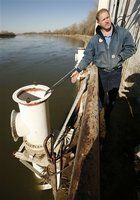The problem is this: Parts of the nation's longest river are losing elevation. The so-called "degradation" process is not affecting the amount of water in the channel, but the water is physically lower on the Earth because the river bottom is washing away.
The water depth is not changing, and the situation is nearly imperceptible from shore. But for engineers, it's a costly headache.
"Part of the whole problem is it's not visible," said John Grothaus, chief of planning for the Army Corps of Engineers in Kansas City, where the river bed has dropped by about 12 feet over the last 50 years.
"It's not in the public eye. You can't see it on the river".
As engineers try to figure out why, the phenomenon threatens to damage billions of dollars in property, weaken levees and bridges, and expose navigation hazards such as sunken piers and underwater pipelines.
Degradation has been observed in waterways across the country, but many scientists are focused on the Missouri River, which is used for shipping many agricultural products and provides drinking water to many cities.
Researchers do not know exactly why the channel is sinking in places from southeast Nebraska to St. Louis, but possible causes include natural erosion and the effects of man-made structures such as dams.
Researchers are unsure whether the process can be reversed or how much it would cost to do so.
As the river drops, it also erodes the banks and bottoms of tributaries that flow into the main channel, causing similar problems there.
But the greatest risk is to infrastructure such as bridges. When the river bed erodes, it exposes more of the pylons that hold up bridges. That reduces the support the foundation gets from being buried in the ground.
For instance, a bridge designed to have its pylons buried 10 feet in the river bed might now be buried only 8 feet deep. If not corrected, the erosion can increase the risk for collapse.
"You have to look if that were allowed to continue, what could be the problem that could occur," said Christina Ostrander, the corps' project manager.
Also at risk are levees such as those separating the Missouri River from an estimated $20 billion in developments, including Kansas City's downtown airport, a General Motors plant and the entire suburb of North Kansas City.
The Missouri begins near Three Forks, Mont., and flows south into the Mississippi north of St. Louis. Since at least the 1920s, its elevation has gradually declined, but the drop has been precipitous over the last decade. The start of the most rapid decline seems to be the 1993 flood, which took several feet out of the river.
And through the middle part of the 2000s, the average annual elevation has fallen by nearly a foot per year. Compounding the problem has been a drought that also reduced river levels.
That's what concerns Missouri's six dredging companies, which can scoop up from the river about 7 million tons of sand and gravel every year to make concrete and build roads. Dredgers are sensitive about getting blamed for degradation, and they are paying for an environmental study of their work.
Jefferson City attorney David Shorr, who represents dredging companies, said the Army Corps' own projects have been designed to cut away the river bottom to ease the need for dredging.
"The Corps is charged with the responsibility to create a navigation channel by Congress. They did that and did it well," said Shorr, who described the river engineering as "a self-scouring system."
Researchers have several theories to explain why the Missouri River is sinking:
Less sediment: Dams trap silt upstream, sending clearer water downstream that does not have as much material to replace what the river erodes. Tributaries also are carrying less material into the channel.The Corps hopes that a preliminary study will provide some answers. The initial draft of the report was to be completed by January.
Natural processes: Rivers cause natural erosion and gradually ease bends such as those that twist around Kansas City. And floods can degrade river bottoms.
Other man-made structures: Levees, dikes and other projects confine the river's natural flow and can cause it to strip away the river bottom.
The effects of the sinking river are becoming clear.
In Kansas City, officials have spent more than $4 million to ensure that the community's drinking-water pumps reach lower river levels. The water supplier in Jefferson City has applied for a permit to lower its intake pipes.
Kansas City leaders are also considering using a horizontal well to tap underground liquefied sands and ease dependence on the river.
In the Kansas City suburb of Parkville, degradation in a creek upstream from the Missouri River caused the stream banks to collapse and threatened baseball fields and two bridges, including one more than a century old.
In 2007, the town had to stabilize the banks and terrace the stream bed at a cost of about half the community's budget for parks, streets, public works and sewer systems.
Mike Klender, assistant manager of operations for the Kansas City water department, said managing the complexities of the dropping river is a challenge.
"It's not any easy task," he said. "I don't envy the Corps with trying to juggle all these issues. It is a daunting task that they have."




Reader Comments
to our Newsletter